Landscaping possesses the transformative power to morph any outdoor space into a breathtaking vista. A meticulously garden design not only elevates the visual appeal of a property but serves as a tranquil retreat from the bustle of daily life. The interplay of colors, textures, and designs invites nature closer, establishing an oasis that captivates the eye and soothes the soul.
This blog exists as a guide, lighting the path for those eager to unveil the full potential of their outdoor spaces. From lush lawns to garden design and build enchantingly, a well-orchestrated landscape serves more than an aesthetic purpose—it nurtures serenity in the heart of chaos. Here, we delve into the elements of landscaping, focusing on the key elements that promise to transform any exterior into a haven of peace and beauty.
Understanding the intricacies of landscape design, from the careful selection of plants to the strategic placement of water features and walkway, opens up a realm of possibilities. Our aim is to arm our readers with the knowledge and inspiration needed to conceptualize and execute their own garden sanctuary.
1. Choosing the Right Plants
Embarking on the journey of landscaping demands a thoughtful selection of flora that not only enhances the beauty of your garden but thrives in its environment.
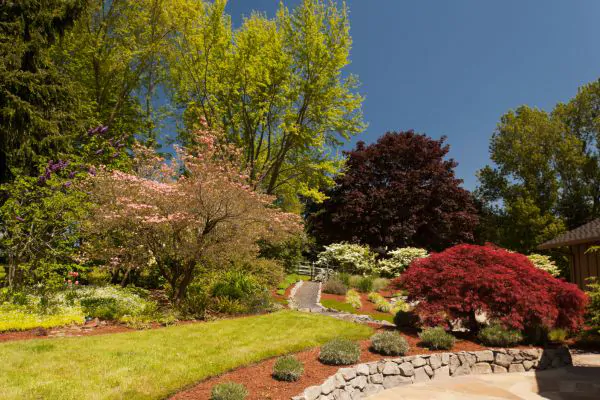
The cornerstone of creating a lush, vibrant landscape lies in choosing the right plants, a task that requires a keen understanding of your local climate and an appreciation for botanical diversity.
This section navigates the crucial considerations of selecting plants that are best suited to your weather conditions and incorporating a harmonious blend of trees, shrubs, flowers, and groundcovers to achieve a landscape design that exudes vitality year-round.
A. Selecting Plants Based on Climate
The choice of plants, profoundly influenced by the climate, sets the foundation for a thriving garden. Native species, accustomed to the local weather patterns, ensure resilience and reduce the need for extensive maintenance. Understanding the microclimate of your property, from full sun exposure to shaded areas, enables the selection of plants destined to flourish, ensuring the landscape remains vibrant through the seasons.
B. Incorporating a Variety of Plant Types
A diverse landscape, rich in various plant types, creates a tapestry of color and texture that enhances the landscape’s aesthetics and ecological balance. Incorporating a blend of trees, shrubs, perennials, and groundcovers not only adds dimension and interest but also supports a vibrant ecosystem, inviting pollinators and wildlife into the space. This approach to plant selection ensures the garden remains captivating and full of life throughout the changing seasons.
2. Focal Points in Landscape Design
In the nuanced world of landscaping, focal points act as the anchors of visual interest, guiding the viewer’s gaze through the ebb and flow of the garden design.
Whether it’s a striking tree, an artfully crafted pergola, or the serene flow of a water feature, focal points draw the eye, creating moments of pause and admiration.
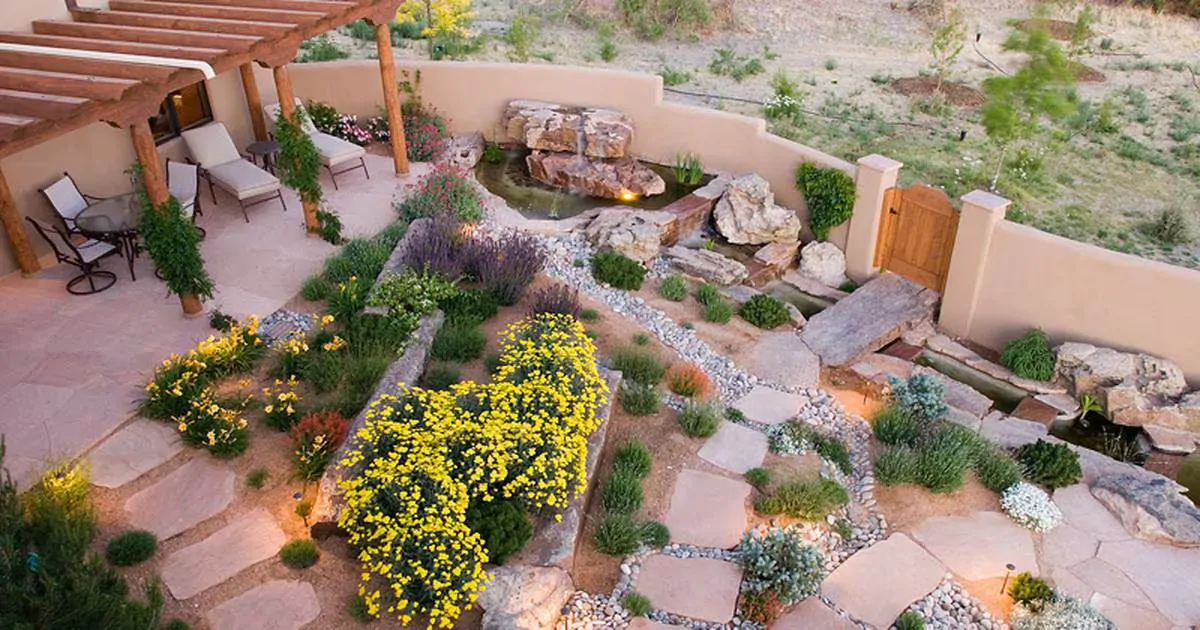
These elements not only punctuate the landscape but also imbue it with a sense of structure and purpose.
Exploring the importance of these anchors reveals how they can dramatically enhance the overall landscape architecture and harmony within a property.
A. Importance of Focal Points
Focal points serve as the heartbeat of landscape design, instantly drawing attention and establishing a narrative within the property. By strategically positioning elements like ornate sculptures or vibrant flower beds, lawn and landscape companies create a visual journey, guiding the observer’s eye through the space. These pivotal features not only add depth and character but also underscore the garden’s thematic essence, making them indispensable in crafting engaging outdoor scenes.
B. Incorporating Statues or Pergolas
Including statues or pergolas within the landscape elevates the visual and emotional appeal of the garden, inviting moments of reflection or gathering. Statues can serve as landmarks or tell stories that add depth to the garden’s narrative, while pergolas create shaded retreats that frame the beauty of nature, and the gentle sound of water from fountains or streams introduces a calming ambiance that draws visitors deeper into the outdoor sanctuary. Each of these elements, thoughtfully chosen and positioned, transforms the ordinary into the extraordinary, making the landscape a living work of art that engages the senses and nurtures the soul.
Related Post: The Difference Between Formal And Informal Landscape Design
3. Creating Paths and Seating Areas
The thoughtful addition of paths and seating areas further enhances the journey through a meticulously landscape. These elements are as crucial to the design as the flora themselves, offering both function and reprieve in the outdoor oasis.
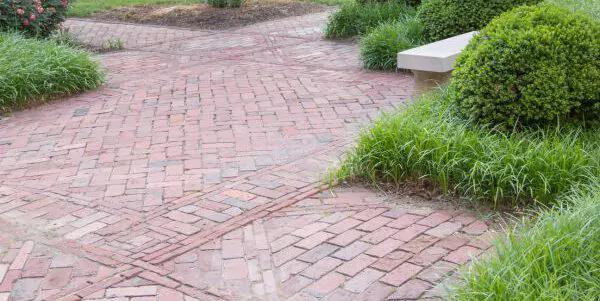
Designing functional pathways ensures a seamless flow throughout the garden, guiding visitors on a deliberate journey through the beauty and variety of its features.
Meanwhile, planning comfortable seating spaces invites guests to pause, reflect, and immerse themselves in the tranquil ambiance of the garden. The harmony between movement and rest underpins the creation of an outdoor space that is both engaging and restorative.
A. Designing Functional Pathways
Designing functional pathways is not merely about connecting different segments of the garden; it’s an art that elegantly guides guests through the landscape, inviting them to discover its hidden treasures. Well-conceived paths strike a balance between practicality and aesthetics, crafted from materials that complement the garden’s overall design while ensuring durability and ease of movement. This thoughtful arrangement not only enhances the garden’s accessibility but also weaves a narrative that engages and surprises at every turn.
B. Planning Comfortable Seating Spaces
Integrating comfortable seating areas into the landscape requires more than simply placing chairs and benches; it demands thoughtful consideration of location, comfort, and context. Nestled under a leafy tree canopy or facing a captivating water feature, these restful spots invite visitors to linger in the garden’s embrace, surrounded by the serenity of nature. By harmonizing seating with the surrounding landscape, lawn, and landscape companies create inviting nooks that enhance the garden’s aesthetics while offering a respite where one can pause, breathe, and reconnect with the outdoor environment.
4. Incorporating Water Features and Irrigation
The allure of a garden is magnified by the introduction of water features, transforming it into a sanctuary where tranquility reigns supreme. Beyond their visual appeal, these elements play a crucial role in the ambiance and ecosystem of the outdoor space.
From the serene murmur of a babbling brook to the reflective calm of a pond, water brings life and motion, crafting an ever-evolving landscape.
Yet, the inclusion of such features and their complementary irrigation systems necessitates careful consideration of both practicality and maintenance.
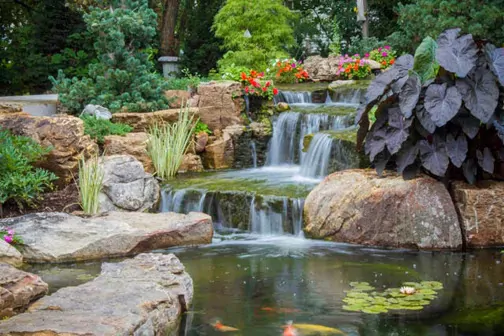
Ensuring longevity and ease of care while enhancing the garden’s aesthetic and auditory experience is paramount. This section explores the dual focus of infusing gardens with the serene beauty of water elements while addressing the pragmatic aspects of their upkeep.
You might like: Spray VS. Drip Irrigation Systems
A. Adding Tranquility with Water Elements
The tranquil sound of water gently cascading in a garden not only offers a melodious backdrop but also fosters a profound sense of calm and connection with nature. By carefully integrating water features such as ponds, waterfalls, or streams into the landscape, garden designers are able to create a magical ambiance that enhances the garden’s aesthetics while inviting wildlife to partake in this serene habitat. This harmonious blend of beauty and functionality enriches the outdoor experience, making water essentials one of the pivotal elements of landscape gardening.
B. Considering Practicality and Maintenance
While the beauty and serenity of water features enhance any garden, the success of these elements heavily relies on acknowledging their maintenance requirements and incorporating efficient irrigation systems. Doing so ensures these enchanting features flourish over time, sustaining the garden’s allure without imposing undue upkeep burdens on the property owner. This careful planning aids in averting potential issues such as water stagnation and system failure, preserving the tranquility and vitality of the landscape.
5. Maintenance Tips for a Lush Landscape
A lush landscape, resplendent with vibrant flora and meticulously designed features, requires diligent maintenance to preserve its beauty and health. Key to this endeavor is regular pruning and trimming alongside effective weed control and mulching practices.
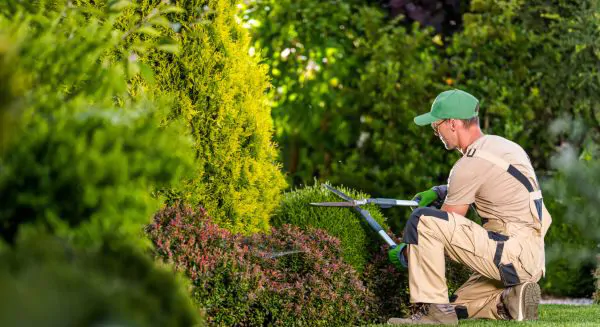
These maintenance activities not only keep the garden looking pristine but also play pivotal roles in promoting plant health and preventing the encroachment of unwanted plants. By adhering to these maintenance regimes, gardeners can ensure their landscapes remain dynamic and flourishing, echoing the ingenuity and care invested in their creation.
A. Regular Pruning and Trimming
Regular pruning and trimming stand as fundamental practices in maintaining the vitality and shape of a garden’s plant life. This diligent care encourages healthy growth, allowing sunlight and air to reach the inner parts of bushes and trees, which in turn fosters a robust landscape. Importantly, these techniques also prevent the spread of plant diseases, ensuring the longevity and flourishing of the garden’s diverse flora.
B. Weed Control and Mulching
Weed control and mulching serve as crucial components in sustaining a landscape’s health and aesthetics. By carefully applying mulch, gardeners can suppress the growth of weeds, retain moisture in the soil, and enhance its fertility, thus creating a more stable and nurturing environment for plants to thrive. This dual approach not only keeps the landscape tidy and visually appealing but also fortifies the plants’ resilience against pests and diseases.
Conclusion
The key elements of landscaping play a pivotal role in transforming outdoor spaces into breathtaking sanctuaries that offer both visual appeal and serene retreats.
Selecting the right plants based on climate and incorporating diverse plant types enrich the landscape’s vibrancy and ecological health. Focal points, including statues, pergolas, and water features, draw the eye and create central areas of interest, enhancing the overall aesthetics and harmony of the garden.
Thoughtfully designed paths and seating areas invite visitors to explore and relax within the natural setting, creating a seamless blend of movement and repose.
Incorporating water features adds a tranquil ambiance and fosters a connection with nature while also requiring mindful consideration of maintenance and irrigation to ensure sustainability.
Regular maintenance practices such as pruning, trimming, and mulching are crucial for preserving the landscape’s lushness and vitality.
In crafting engaging and restorative outdoor environments that echo with tranquility and design, contact EVERGREEN LANDSCAPE PROS.





